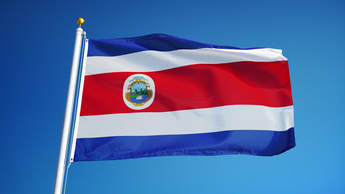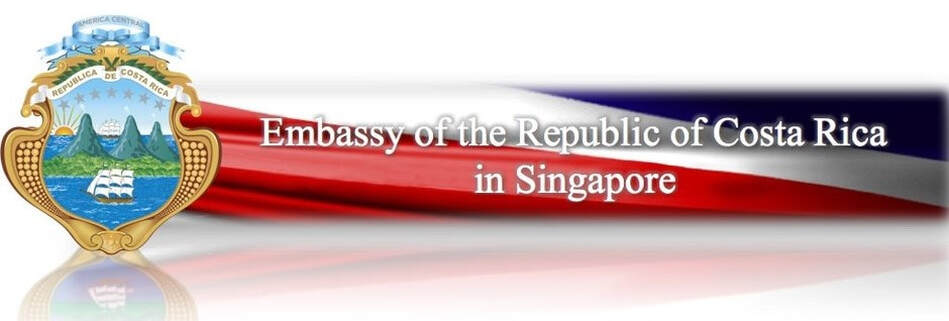National Symbols of Costa Rica

National Symbols of Costa Rica. The symbols of Costa Rica are the flag, the motto, the anthem, the coat of arms, the national flower and more.
The Flag
According to a law passed on September 29, 1848, Costa Rica’s national flag is “tricolour with five horizontal stripes […] a middle red stripe will be placed between two white stripes, each of which will be followed by blue stripes”. Each one of the stripes occupies one sixth of the height of flag, except the red one which occupies two sixths.
The National Coat of Arms
Costa Rica’s national coat of arms was established on the same date as the national flag. It is defined as follows: in the centre, three volcanoes and one valley appear between two seas with merchants sailing on each of the two sea’s waters. To the left on the horizon, a rising sun emits its rays. Five stars form an arch over the volcanoes and symbolise the country’s departments (in 1964, the number of stars was increased to seven to adapt to changes produced in the way the land was organised).
Two branches of myrtle will appear above this scene, holding up a strip of ribbon that reads “República de Costa Rica”, and above this, a blue strip of ribbon in the shape of a crown will bear the words “América Central”.
National Anthem
The original sheet music by Manuel Maria Gutierrez is dated at 1852. He wrote the piece in just three days, when a national anthem was urgently needed before the arrival of US dignitaries. The lyrics were penned by Jose Maria Zeledon Brenes, which were declared official in 1949 after a long series of alternative lyrics had been considered since 1879. Costa Rican National Anthem.
National Flower
La Guaria Morada (Guarianthe skinneri). Toward the end of the 1930’s, the director of Argentina’s parks and gardens and the Annual Tropical Flower exposition of Miami needed a Costa Rican national flower. The Rotary Club and the Garden Club organised a competition to select the flower. The competition was to be held throughout the entire country and the flowers entered had to be native to America and present in Costa Rican traditions and legends. The “Cattleyaskinneri” (Guaria Morada) was selected as the national flower on June 15, 1939.
National Tree
Guanacaste. The EntelorobiumCyclocarpum, known as Guanacaste, was chosen as the national tree of Costa Rica on August 31, 1959 as a symbol of the Costa Ricans great interest in nature and its conservation, as the tree itself symbolises abundance and protection.
National Bird
The yigüirro (clay-coloured thrush). This cheerful bird symbolises the optimistic attitude of the people of Costa Rico. It was declared the national bird in 1977.
National Symbol of Work
The carreta costarricense (Costa Rican ox-cart). This simple but beautiful vehicle and work tool was designated in 1988 as the national symbol of work. During the 19th century and much of the 20th, this cart was the only means used to transport and haul coffee, the economic engine of the country.
National Symbol of Wildlife
The white tailed deer. This deer species is in danger of extinction due to illegal hunting and the destruction of its natural habitat. The animal can live in the mountains or at sea level, but it prefers the savannahs of Guanacaste such as those found in Santa Rosa National Park. It was declared a national symbol in May of 1995.
National Musical Instrument
The marimba. This instrument is present in all popular Costa Rican celebrations. The country’s most important marimba production centre is in the province of Guanacaste, although the instrument is played throughout Costa Rica. A decree from the president of the country and the secretary of culture gave the instrument national status in 1996.
Symbol of Peace and Liberty
The torch of independence. Juan Santamaria, a national hero in Costa Rica, carried a torch that helped lead to victory against William Walker’s filibusterers in the 1856 battle of Rivas. Since 2005, the torch of independence has been considered “the national symbol that exalts national patriotic civic sentiments.
Symbol of Nature
The crests of Chirripó National Park. These rock formations considered of “great natural and aesthetic value” were officially declared a national symbol on April 25, 2011.
It’s interesting how a country as small as Costa Rica can have so many official national symbols. Perhaps the absence of an army and the renunciation of militarism may be the reason that Costa Ricans enjoy their time observing their surroundings and placing value on that which is important to them.
The Flag
According to a law passed on September 29, 1848, Costa Rica’s national flag is “tricolour with five horizontal stripes […] a middle red stripe will be placed between two white stripes, each of which will be followed by blue stripes”. Each one of the stripes occupies one sixth of the height of flag, except the red one which occupies two sixths.
The National Coat of Arms
Costa Rica’s national coat of arms was established on the same date as the national flag. It is defined as follows: in the centre, three volcanoes and one valley appear between two seas with merchants sailing on each of the two sea’s waters. To the left on the horizon, a rising sun emits its rays. Five stars form an arch over the volcanoes and symbolise the country’s departments (in 1964, the number of stars was increased to seven to adapt to changes produced in the way the land was organised).
Two branches of myrtle will appear above this scene, holding up a strip of ribbon that reads “República de Costa Rica”, and above this, a blue strip of ribbon in the shape of a crown will bear the words “América Central”.
National Anthem
The original sheet music by Manuel Maria Gutierrez is dated at 1852. He wrote the piece in just three days, when a national anthem was urgently needed before the arrival of US dignitaries. The lyrics were penned by Jose Maria Zeledon Brenes, which were declared official in 1949 after a long series of alternative lyrics had been considered since 1879. Costa Rican National Anthem.
National Flower
La Guaria Morada (Guarianthe skinneri). Toward the end of the 1930’s, the director of Argentina’s parks and gardens and the Annual Tropical Flower exposition of Miami needed a Costa Rican national flower. The Rotary Club and the Garden Club organised a competition to select the flower. The competition was to be held throughout the entire country and the flowers entered had to be native to America and present in Costa Rican traditions and legends. The “Cattleyaskinneri” (Guaria Morada) was selected as the national flower on June 15, 1939.
National Tree
Guanacaste. The EntelorobiumCyclocarpum, known as Guanacaste, was chosen as the national tree of Costa Rica on August 31, 1959 as a symbol of the Costa Ricans great interest in nature and its conservation, as the tree itself symbolises abundance and protection.
National Bird
The yigüirro (clay-coloured thrush). This cheerful bird symbolises the optimistic attitude of the people of Costa Rico. It was declared the national bird in 1977.
National Symbol of Work
The carreta costarricense (Costa Rican ox-cart). This simple but beautiful vehicle and work tool was designated in 1988 as the national symbol of work. During the 19th century and much of the 20th, this cart was the only means used to transport and haul coffee, the economic engine of the country.
National Symbol of Wildlife
The white tailed deer. This deer species is in danger of extinction due to illegal hunting and the destruction of its natural habitat. The animal can live in the mountains or at sea level, but it prefers the savannahs of Guanacaste such as those found in Santa Rosa National Park. It was declared a national symbol in May of 1995.
National Musical Instrument
The marimba. This instrument is present in all popular Costa Rican celebrations. The country’s most important marimba production centre is in the province of Guanacaste, although the instrument is played throughout Costa Rica. A decree from the president of the country and the secretary of culture gave the instrument national status in 1996.
Symbol of Peace and Liberty
The torch of independence. Juan Santamaria, a national hero in Costa Rica, carried a torch that helped lead to victory against William Walker’s filibusterers in the 1856 battle of Rivas. Since 2005, the torch of independence has been considered “the national symbol that exalts national patriotic civic sentiments.
Symbol of Nature
The crests of Chirripó National Park. These rock formations considered of “great natural and aesthetic value” were officially declared a national symbol on April 25, 2011.
It’s interesting how a country as small as Costa Rica can have so many official national symbols. Perhaps the absence of an army and the renunciation of militarism may be the reason that Costa Ricans enjoy their time observing their surroundings and placing value on that which is important to them.

